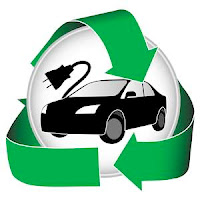| Pulling out of garage on electric power |
Yahoo! It works! After carefully charging the battery pack and working out a number of bugs in the setup of the battery management system (BMS), I decided it was time to take the truck out for a quick spin around the neighborhood. What a thrill--nothing blew up, nothing caught fire, nothing shorted out. I had a scare for a few moments when there was a weird whirring noise which didn't stop when the vehicle did, but I quickly realized it was the vacuum pump for the power brakes--it's working properly too, yeah!
| EV in the neighborhood |
The drive was really short, just up the block and back twice. I had no hood, no lights, no bed, laptop on the seat next to me logging data. Didn't want to go too far. It was cool and weird to be driving an making no noise except tire noise. I think I'm going to like this.
| A happy EV driver |
The purpose of this test drive, in addition to see if it worked at all, was to determine if my sensors on the drive side of the system were working. I had some indication that my current pickup on the discharge side of the battery system wasn't working correctly. I found out that was true, so now I've got to troubleshoot that. Without this current pickup I can't tell how much of the charge I've used up--in other words I'd be driving around without a fuel gauge. There's a long list of stuff that needs to get done before I can have a working EV, including:
- Fixing the current pickup on the discharge side
- Testing the controls on the discharge side to ensure the system shuts down when batteries are empty
- Fixing the short in the heater
- Making and installing battery and motor controller covers
- Bleeding the brakes
- Putting the dashboard back in and installing the new gauges
- Putting the hood back on
- Reinstalling the bed with a hinge and lift system






